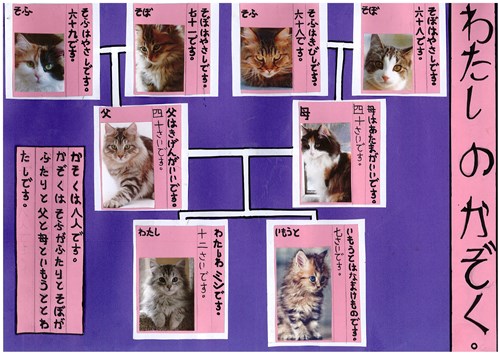Languages: Japanese - Satisfactory - Years 7 and 8 (Year 7 entry)
Portfolio summary
This portfolio of student work shows that the student can interact with peers and the teacher in classroom routines and activities (WS3), exchanging greetings, wishes and information about their personal and social worlds (WS2, WS4). The student uses gestures and formulaic expressions appropriately. The student comprehends and responds to familiar questions and instructions and asks for assistance and clarification (WS3). The student pronounces voiced and unvoiced sounds, long vowels, blends, double consonants and high-frequency loan words with developing rhythm and intonation (WS2, WS4). The student reads and writes texts in hiragana and katakana (WS2, WS5, WS6), with some kanji for numbers (WS1), days of the week and high-frequency nouns, adjectives (WS1, WS5) and verbs (WS3, WS5). The student uses rehearsed language related to personal world to convey information in both written (WS1, WS5) and spoken texts (WS1, WS2, WS3, WS4). The student produces short sentences involving nouns (WS1, WS5), verbs (WS3, WS5), common counter classifiers (WS1, WS2, WS4), and adjective, noun (WS1, WS5) and verb predicates (WS1). The student applies correct stroke order to all characters (WS3), and uses appropriate punctuation (WS1) and textual features in texts such as captions, greeting cards, profiles, emails or timelines (WS5). The student structures sentences using correct word order (WS1, WS3, WS4, WS5). The student translates and interprets short texts (WS6), explaining Japanese expressions that do not readily translate into English (WS5, WS6). The student adjusts language to suit different contexts and situations (WS2, WS4, WS5) and responds in culturally appropriate ways to interactions with other Japanese speakers (WS2, WS4, WS5).
The student recognises the nature and roles of the three Japanese scripts (WS1, WS6), understanding that hiragana represents the basic unit of Japanese sound, kanji represents meaning (WS1), and katakana is used for borrowed words (WS2, WS3, WS6). The student uses the hiragana (WS1) and katakana chart as a tool when writing and reading, recognising their systematic nature (WS1, WS3). The student knows that hiragana and katakana are pronounced identically and that the pronunciation of borrowed words is determined by the Japanese sound system (WS3, WS6). The student understands and applies grammatical concepts such as the use of particles (WS2, WS5, WS6) and conjugation of present, past, positive and negative forms of verbs (WS5). The student understands and uses いand なadjectives (WS4, WS5), and applies the rules of counter classifiers (WS1). The student explains how language and behaviour change according to participants, context and relationship (WS2, WS6), and that politeness and respect are expressed explicitly in Japanese through greetings, vocabulary, formulaic expressions and actions (WS2, WS3, WS5, WS6). The student makes connections and comparisons between elements of the Japanese language and culture and their own, identifying how languages reflect ways of thinking and behaving (WS3, WS5, WS6). The student identifies how Japanese values such as humility and harmony are reflected in language, such as by deflecting praise (WS5).





